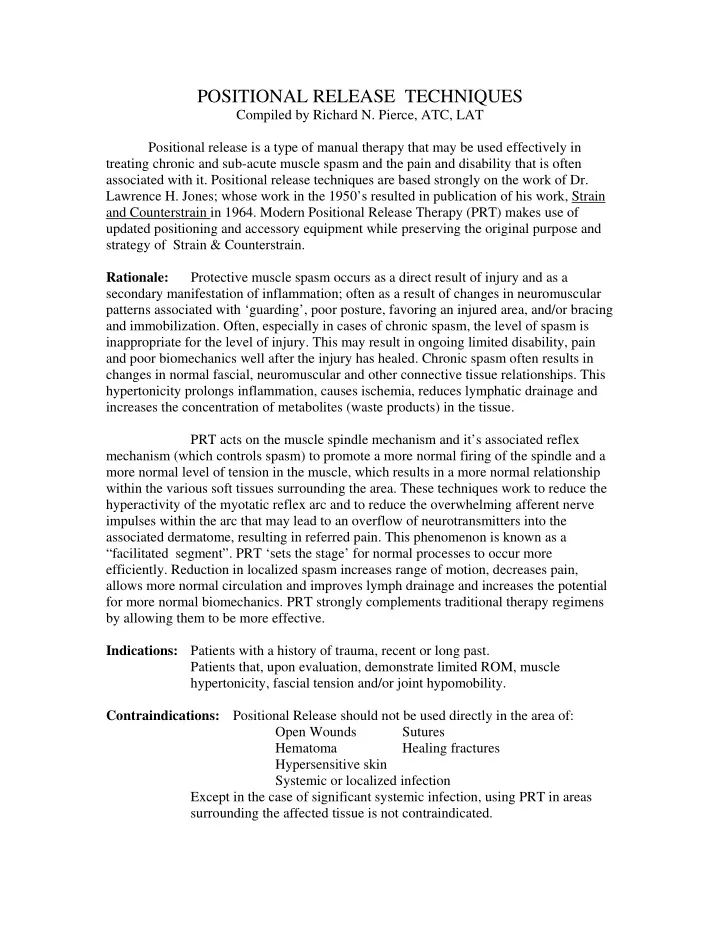

POSITIONAL RELEASE TECHNIQUES Compiled by Richard N. Pierce, ATC, LAT Positional release is a type of manual therapy that may be used effectively in treating chronic and sub-acute muscle spasm and the pain and disability that is often associated with it. Positional release techniques are based strongly on the work of Dr. Lawrence H. Jones; whose work in the 1950’s resulted in publication of his work, Strain and Counterstrain in 1964. Modern Positional Release Therapy (PRT) makes use of updated positioning and accessory equipment while preserving the original purpose and strategy of Strain & Counterstrain. Rationale: Protective muscle spasm occurs as a direct result of injury and as a secondary manifestation of inflammation; often as a result of changes in neuromuscular patterns associated with ‘guarding’, poor posture, favoring an injured area, and/or bracing and immobilization. Often, especially in cases of chronic spasm, the level of spasm is inappropriate for the level of injury. This may result in ongoing limited disability, pain and poor biomechanics well after the injury has healed. Chronic spasm often results in changes in normal fascial, neuromuscular and other connective tissue relationships. This hypertonicity prolongs inflammation, causes ischemia, reduces lymphatic drainage and increases the concentration of metabolites (waste products) in the tissue. PRT acts on the muscle spindle mechanism and it’s associated reflex mechanism (which controls spasm) to promote a more normal firing of the spindle and a more normal level of tension in the muscle, which results in a more normal relationship within the various soft tissues surrounding the area. These techniques work to reduce the hyperactivity of the myotatic reflex arc and to reduce the overwhelming afferent nerve impulses within the arc that may lead to an overflow of neurotransmitters into the associated dermatome, resulting in referred pain. This phenomenon is known as a “facilitated segment”. PRT ‘sets the stage’ for normal processes to occur more efficiently. Reduction in localized spasm increases range of motion, decreases pain, allows more normal circulation and improves lymph drainage and increases the potential for more normal biomechanics. PRT strongly complements traditional therapy regimens by allowing them to be more effective. Indications: Patients with a history of trauma, recent or long past. Patients that, upon evaluation, demonstrate limited ROM, muscle hypertonicity, fascial tension and/or joint hypomobility. Contraindications: Positional Release should not be used directly in the area of: Open Wounds Sutures Hematoma Healing fractures Hypersensitive skin Systemic or localized infection Except in the case of significant systemic infection, using PRT in areas surrounding the affected tissue is not contraindicated.
Caution should be used when working on the neck to avoid vertebral artery compression. Other Considerations: Comfort of the patient is paramount. The goal is relaxation of the affected body parts and the body in general. Constant communication between the patient and care provider is essential Care giver comfort is important; protect your own body from injury. Anticipate awkward positions and consider the weight of body parts that you will have to hold steady for 90 seconds. Be prepared to use props to help you maintain therapeutic positions. An electric hi-lo treatment table is ideal. Procedure: Evaluate the patient’s needs via: medical Hx, Px, etc. Position the patient comfortably; most often lying down. Palpate the affected area and areas that may be associated due to referred pain. W/ multiple tender points, treat the most severe first. Palpate the selected tender point (TP) – instruct the pt. to relax the area. Passively move the appropriate body part to release tension at the TP. Stop motion when the pain stops and pt. only feels pressure. Communicate! Release the pressure – but maintain light contact over the TP to monitor response. Maintain the position for 90 seconds. Hold longer if patient or ATC is feeling a therapeutic pulse, tissue tension changes or movement. Encourage the patient to relax – slowly return to neutral position. Recheck the TP - expect 70% improvement in pain level and reduced tension. Points to remember: Your knowledge of anatomy, referred pain patterns, actions of muscles and biomechanical relationships is important. The more you know – the more effective your treatment! Your treatment can be effective even with basic knowledge! Constant support of the treatment area during the 90 sec. is critical. Anterior TP are usually treated in flexion. Posterior TP “ “ “ in extension Midline or close-to-midline TP are often treated w/ flexion or extension.
Lateral to midline TP are treated with more rotation and/or side bending. With multiple TP – treat most severe first. With rows of TP (of nearly equal tenderness) – treat the one in the middle first. TP in the extremities are often found on the opposite side of pain. Patients may get achy or a tired feeling following multiple point PRT – warn them. Usually this will disappear the next day as they begin normal activity. Protect your own body by anticipating awkward positions, using props and moving between periods of treatment. Share your knowledge!! References: Positional Release Therapy Kerry J. D’Ambrogio & George B. Roth Publ. by Mosby-Year Book, Inc. (1997) ISBN 0-8151-0096-5 Jones Strain Counterstrain Lawrence H. Jones, DO 1995 ISBN-13: 978-0964513549 Referred Pain Patterns and info on Physiology of Pain & Spasm: Myofascial Pain and Dysfunction; The Trigger Point Manual Volumes 1 (Upper Body) and 2 (Lower Body) Janet D. Travell, MD & David G. Simons, MD Publ. by Williams & Wilkins (1983) ISBN 0-683-08366-X Courses & Practitioners: The Jones Institute 7937 Corte Domingo Carlsbad, CA 92009 jiscs.com 12/11
Recommend
More recommend